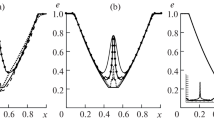Abstract
A method for calculating weakly coupled systems by the Monte Carlo method, used in the MCU-REA program, is described. Computational tests, prepared by an international expert group OECD/NEA, is used for verification. The results of calculations of some of them and their comparison with results obtained using other programs are presented.
Similar content being viewed by others
References
R. Avery, “Theory of coupled reactors,” in: 2nd International Conference on Peaceful Uses of Atomic Energy, Geneva, Selected Reports by Foreign Scientists, Vol. 3, Physics of Nuclear Reactors, Atomizdat, Moscow (1960), pp. 231–340.
V. G. Zolotukhin and L. V. Maiorov, Estimate of the Criticality Parameters of Reactors by the Monte Carlo Method, Energoatomizdat, Moscow (1984).
L. V. Maiorov, “Estimates of the bias in the results of a calculation of nuclear reactors and storage sites for nuclear fuel by the Monte Carlo method,” At. Energ., this issue, Russian pp. 243–256.
G. Whiteside, “A difficulty in computing the K-effective of the world,” Trans. Am. Nucl. Soc., 14, No.2, 26–40 (1971).
R. Blomquist and E. Gelbard, “Monte Carlo criticality source convergence in a loosely coupled fuel storage system,” in: Proceedings of ICMC 2003, Tokyo, Japan, October 20–24, 2003, Vol. 5, pp. 500–507.
M. Armisnaw, R. Blomquist, A. Nouri, et al., “OEDC/NEA source convergence benchmarks program: overview and summary of results,” ibid., Vol. 3, pp. 278–282.
J. Yang and Y. Naito, “The sandwich method for determining source convergence in Monte Carlo calculation,” ibid., Vol. 3, pp. 360–366.
T. Kuroishi and Y. Nomura, “Implementation of the convergence judgment method to OECD/NEA benchmark problems,” ibid., Vol. 5, pp. 508–512.
“MCU-REA program with the DLC/MCUDAT-2.1 constants library,” Vopr. At. Nauk. Tekh., Ser. Fiz. Yad. Reakt., No. 3, 55–62 (2001).
V. B. Polevoi, “Estimate of the number of preliminary generations in the problem ‘K-effective of the world’,” in: Neutronics-99 (2000), pp. 99–102.
H. Kadotani, “Acceleration of fission distribution convergence using eigenvectors from the matrix k calculations in the KENO code,” in: Proceedings of ICNC 91, Oxford (1991), Vol. 1, pp. II-1–II-10.
V. F. Kolesov and V. Kh. Khoruzhii, “Neutron characteristics of models of a cascade two-section reactor,” At. Energ., 88, No.5, 330–337 (2000).
Author information
Authors and Affiliations
Additional information
__________
Translated from Atomnaya Energiya, Vol. 99, No. 4, pp. 256–264, October, 2005.
Rights and permissions
About this article
Cite this article
Oleinik, D.S. Monte Carlo Calculation of Weakly Coupled Systems. At Energy 99, 694–701 (2005). https://doi.org/10.1007/s10512-006-0002-y
Received:
Issue Date:
DOI: https://doi.org/10.1007/s10512-006-0002-y




